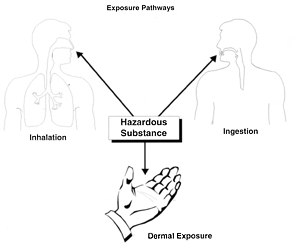Hazardous Substances and Hazardous Waste
|

1: Hazardous Substances and Hazardous Waste Chemicals affect our everyday lives. They are used to produce almost everything we use, from paper and plastics to medicines and food to gasoline, steel, and electronic equipment. More than 70,000 chemicals are used regularly around the world. Some occur naturally in the earth or atmosphere, others are synthetic, or human-made. When we use and dispose of them properly, they may enhance our quality of life. But when we use or dispose of them improperly, they can have harmful effects on humans, plants, and animals. What is hazardous waste? Even when used properly, many chemicals can still harm human health and the environment. When these hazardous substances are thrown away, they become hazardous waste. Hazardous waste is most often a by-product of a manufacturing process - material left after products are made. Some hazardous wastes come from our homes: our garbage can include such hazardous wastes as old batteries, bug spray cans, and paint thinner. Regardless of the source, unless we dispose of hazardous waste properly, it can create health risks for people and damage the environment. What kinds of hazardous waste are there? Most hazardous
waste is identified by one or more of its dangerous properties or characteristics:
corrosive, ignitable, reactive, or toxic.
Where does hazardous waste go? Ideally, hazardous waste is reused or recycled. If this is not possible, hazardous waste is safely contained while it is stored, transported, and properly disposed of to prevent an accidental release into the environment. Advances in technology have greatly improved our ability to treat or dispose of hazardous waste in a way that prevents it from harming people or the environment. Typical methods of hazardous waste storage and disposal include surface impoundments (storing it in lined ponds), high temperature incineration (controlled burning), municipal and hazardous waste landfills (burying it in the ground), and deep well injection (pumping it into underground wells). More promising methods focus on minimizing waste, reusing and recycling chemicals, finding less hazardous alternatives, and using innovative treatment technologies. What are the dangers of hazardous waste management? Proper management and control can greatly reduce the dangers of hazardous waste. There are many rules for managing hazardous waste and preventing releases into the environment. Even so, a lot can go wrong when we try to contain hazardous waste. Even the most technologically advanced landfills we build will leak some day. Tanks used for storing petroleum products and other chemicals can leak and catch fire; underground storage tanks weaken over time and leak their hazardous contents. Transportation accidents, such as train crashes and overturned trucks, can occur while transporting hazardous substances. There are also cases of intentional and illegal dumping of hazardous waste in sewer systems, abandoned warehouses, or ditches in remote areas to avoid the costs and rules of safe disposal. How can hazardous waste affect us? When hazardous wastes are released in the air, water, or on the land they can spread, contaminating even more of the environment and posing greater threats to our health. For example, when rain falls on soil at a waste site, it can carry hazardous waste deeper into the ground and the underlying groundwater. If a very small amount of a hazardous substance is released, it may become diluted to the point where it will not cause injury. A hazardous substance can cause injury or death to a person, plant, or animal if:
Coming into contact with a substance is called an exposure. The effects of exposure depend on:
Humans, plants,
and animals can be exposed to hazardous substances through inhalation,
ingestion, or dermal exposure.
Exposures can be
either acute or chronic. An acute exposure is a single exposure
to a hazardous substance for a short time. Health symptoms may appear
immediately after exposure; for example, the death of a fly when covered
with bug spray or a burn on your arm when exposed to a strong acid such
as from a leaking battery. Chronic exposure occurs over a much longer period of time, usually with repeated exposures in smaller amounts. For example, people who lived near Love Canal, a leaking hazardous waste dump, did not notice the health effects of their chronic exposure for several years. Chronic health effects are typically illnesses or injuries that take a long time to develop, such as cancer, liver failure, or slowed growth and development. One reason chronic exposure to even tiny amounts of hazardous substances can lead to harm is bioaccumulation. Some substances are absorbed and stay in our bodies rather than being excreted. They accumulate and cause harm over time. |
![[logo] US EPA](https://webarchive.library.unt.edu/eot2008/20081021002717im_/http://www.epa.gov/epafiles/images/logo_epaseal.gif)





